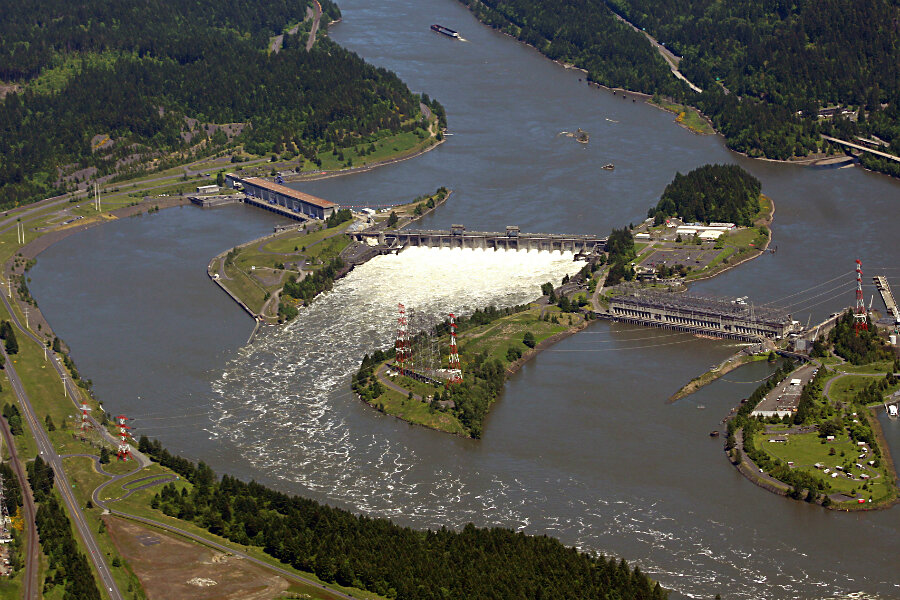Why $700 million to save salmon may not be enough
Loading...
| Portland, Ore.
A massive federal habitat restoration effort in the Columbia River Basin has spent more than $700 million on breaching levies, restoring tidal channels, reconnecting floodplains and other actions meant to boost salmon and steelhead populations imperiled by hydroelectric dams.
Experts say it's likely the largest, most intensive, and most expensive habitat restoration program in the nation. Hundreds of restoration projects in Oregon, Idaho, Washington, and Montana have reopened more than 2,800 miles of habitat.
The monumental scope and price tag stem from habitat restoration's role as the centerpiece in a federal management plan to relieve the damage that dams cause to fish. Critics of the plan say relying heavily on habitat improvements is not enough to restore wild fish runs and take them off the endangered species list.
The plan has changed over the past two decades after several legal challenges; the latest version has also been challenged in court and is scheduled to be debated in front of a judge Tuesday.
In defending the plan, federal officials say record numbers of chinook, coho and sockeye salmon returned in 2014 to the Columbia and its tributaries — thanks in large part, they say, to the improved habitat.
But many of the basin's 13 protected runs of salmon and steelhead are still barely hanging on and most of the returning fish were born in hatcheries, not in the wild — a reality that's leading critics to call for the breaching of four dams.
Prior to European settlement, millions of salmon and steelhead returned every year to the Columbia and its tributaries. But due to overfishing, agricultural water diversions, mining, logging and pollution, salmon populations plummeted.
Biologists estimate that most of the fish habitat was lost or damaged. Construction of energy-producing dams dealt the biggest blow to fish mortality. The management plans — called biological opinions — must mitigate the dams' damage to the threatened or endangered populations and set goals for their survival.
These plans include improving fish passage and making operational changes at the dams, keeping predators such as Caspian terns or sea lions at bay and reducing the impacts of artificially-bred fish on wild ones.
But since 2000, habitat restoration has become the plan's most important strategy. Officials say scientific evidence shows fish survival is directly linked to the quality of their habitat.
The Bonneville Power Administration, the federal agency that markets power from the dams and funds the majority of habitat projects in the basin, is effusive about the program. BPA says changes in habitat are impressive and the fish are using it — in some cases, salmon arrive within a few weeks after habitat is restored.
"We have been highly successful," BPA's Rosy Mazaika said.
But federal scientists overseeing the restoration work are a lot more reserved.
"We're working on it. I'm not going to say it's a qualified success, because not every project has a qualified benefit," said Chris Jordan, a NOAA research scientist who oversees the largest research and monitoring project under the plan.
The biggest challenge, Jordan said, is isolating the factors that limit fish survival and recovery and deciding whether a habitat improvement will make a difference.
"There are so many different ways in which humans have destructed fish habitat for hundreds of years, it becomes hard to know what the limiting factor is," Jordan said. "So even if you put a lot of money into restoring an aspect of habitat, you sometimes don't see any fish response."
Some techniques, such as riparian planting, take time to show impacts, Jordan said. And it takes years for fish to mature, reach the ocean and return to their native streams to spawn — which is the real measure of success.
Another challenge, said NOAA research scientist Phil Roni, is that the government doesn't always choose projects that will have the greatest benefits. When a community, landowner or farmer refuses to cooperate, he said, the money is invested in another less-needed project. And instead of focusing on key watersheds, restoration is spread thin across the entire landscape.
"It's opportunistic, meaning people are doing the projects that they can get done," Roni said. "In most places, the actions aren't big enough, and their choice and scope is limited by money, local cooperation and reasonable time frames."
BPA says its strategy has evolved; the projects it now funds are larger and more data driven. Where an action proves infeasible or ineffective, the agency said it adds other projects.
To plaintiffs who oppose the federal plan in court, that strategy makes little sense.
"We're not saying there is no value in restoring habitat," said Todd True, an attorney with Earthjustice who represents environmental groups in the case. "Good habitat is beneficial, but the elephant in the room is the impact of the dams. Let's address it and not get distracted by the idea that we're spending millions of dollars on habitat so we must be doing something right."
True said the method used by the government to calculate how improvements in habitat translate into higher fish survival is uncertain.
The best way to help fish, True said, is to breach the four lower Snake River dams.
Oregon, which also opposes the plan in court, has a different idea. Oregon officials say habitat alone can't save fish. For example: While there are nearly pristine wilderness areas in Oregon and Idaho, the fish populations in those watersheds are still imperiled.
"To think you can compensate for the effects of dams by habitat restoration is a flawed premise," said Ed Bowles, with the Oregon Department of Fish and Wildlife.
Instead of breaching dams, Oregon wants federal managers to spill more water over dams to get fish past the concrete and quicken their migration to the ocean. Federal agencies oppose this because spilled water doesn't go through the turbines and doesn't produce energy.





